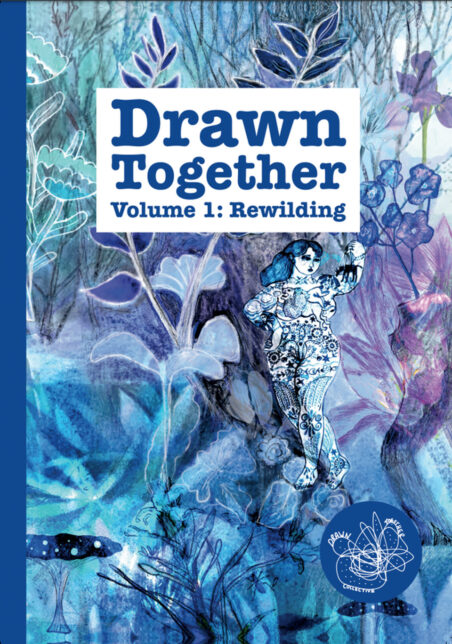Zohra reviews Rewilding…

Rewilding is a dynamic practice in Drawn Together Volume 1: Rewilding. The collection of visual stories by ‘international feminist collective’ Drawn Together invites the reader to morph their human body, mind and soul in order to be able to undertake the process of rewilding. This concept of human transformation is a constant through line connecting each story as women grow wolves tails (Anima, Come Wolf Come), realise they were ‘always the bramble, the ivy and the oak’ (The Glass Mountain), ceramic figures slip out of the confines of the vase (Les Trois Graces) and people find relation with in cows, lions (Dolores Animales) and bees (Bee-Friending.)
Many of the stories evoke rewilding as a return to what Rebecca Myers (Little Pill) calls ‘a less defined and rigid state of being’. Twin, the first story in the collection, portrays the time bending potential of the call to rewild in a woman’s rediscovery of a childhood seashell and the ever-present yawn of deep time. This sense of strange temporality is shared by Return, which is a primordial soup of deep red, burgundy and green in which faces and mouths with bared teeth surface and phosphoresce with red traces and the speaker names nature as ‘my future and my past.’ Rewilding as return is often depicted as bittersweet or uncomfortable, as in Garden Stripes in which a man obsessed with his pristine lawn returns from a hospital stay to find it much changed.
The collection presents rewilding as both work and play. The Tree Lady and Earth Colour, though stylistically disparate, one a grayscale graphite interview narrative, the other a series of artistic exercises on working with water, embody this dual purpose. Both contributions emphasise the importance of giving attention to, and learning from, our natural environments and ecosystems and engage with ideas around ‘making space’ in different ways. Similarly, Wild With Grief explores the ‘work in mourning’ and in Fairies in Arcadia the artist places paper drawings in her garden, writing that she ‘set them to play.’
This sense of play is a constant presence. With a sensitivity characteristic of the collection as a whole Annabel Dover (2017 photo series) and Gina Frankel (Home Office) explore contemporary concerns such as displacement and technology with a naive style. Indeed, the child/like is never far away in this collection, with R.H. Casey’s Where We Wandered evoking Maurice Sendak’s Where the Wild Things Are (1963) in its depiction of a subject whose room becomes a portal into ‘a land out of space and time.’ When Casey’s speaker states that the portal was ‘raining down stars upon my head!’, the described sense of wonder captures how it feels to read this collection.

This video is licensed under a Creative Commons Attribution 4.0 International License.

Comments are closed.